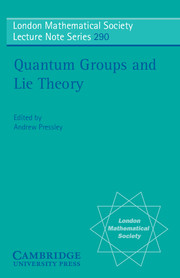Book contents
- Frontmatter
- Contents
- Introduction
- Lectures on Cyclotomic Hecke Algebras
- An Introduction to Group Doublecross Products and Some Uses
- Canonical Bases and Piecewise-linear Combinatorics
- Integrable and Weyl Modules for Quantum Affine sl2
- Notes on Balanced Categories and Hopf Algebras
- Lectures on the dynamical Yang-Baxter Equations
- Quantized Primitive Ideal Spaces as Quotients of Affine Algebraic Varietie
- Representations of Semisimple Lie Algebras in Positive Characteristic and Quantum Groups at Roots of Unity
- The Yang-Baxter Equation for Operators on Function Fields
- Noncommutative Differential Geometry and Twisting of Quantum Groups
- Finite Quantum Groups and Pointed Hopf Algebras
- On Some Two Parameter Quantum and Jordanian Deformations, and their Coloured Extensions
- Tensor Categories and Braid Representations
Introduction
Published online by Cambridge University Press: 05 November 2009
- Frontmatter
- Contents
- Introduction
- Lectures on Cyclotomic Hecke Algebras
- An Introduction to Group Doublecross Products and Some Uses
- Canonical Bases and Piecewise-linear Combinatorics
- Integrable and Weyl Modules for Quantum Affine sl2
- Notes on Balanced Categories and Hopf Algebras
- Lectures on the dynamical Yang-Baxter Equations
- Quantized Primitive Ideal Spaces as Quotients of Affine Algebraic Varietie
- Representations of Semisimple Lie Algebras in Positive Characteristic and Quantum Groups at Roots of Unity
- The Yang-Baxter Equation for Operators on Function Fields
- Noncommutative Differential Geometry and Twisting of Quantum Groups
- Finite Quantum Groups and Pointed Hopf Algebras
- On Some Two Parameter Quantum and Jordanian Deformations, and their Coloured Extensions
- Tensor Categories and Braid Representations
Summary
Since its genesis in the early 1980s, the subject of quantum groups has grown very rapidly. Although much of the groundwork was laid by V. G. Drinfeld in his remarkable talk at the 1986 International Congress of Mathematicians in Berkeley, a number of basic issues in the theory were not resolved until later. In addition, important new developments occurred in the late 1980s and early 1990s, such as the crystal and canonical bases, and the applications of quantum groups in low-dimensional topology. By the late 1990s, however, the theory had reached a stage in which most of the foundational issues had been resolved, and many of the outstanding problems clearly formulated. It was felt that this was an opportune moment to hold a meeting of experts representing all the main strands of the theory, to take stock of what had been achieved so far and to discuss the most fruitful directions for future research. The result was the LMS Durham Symposium on Quantum Groups, which was held at Grey College in the University of Durham from 19 July to 29 July, 1999, and organised by S. Donkin, A. Pressley and A. Sudbery. The present volume is a record of some of the lectures given at the Symposium. Two lecture series are represented here which form excellent surveys of two important areas.
- Type
- Chapter
- Information
- Quantum Groups and Lie Theory , pp. vii - viiiPublisher: Cambridge University PressPrint publication year: 2002



